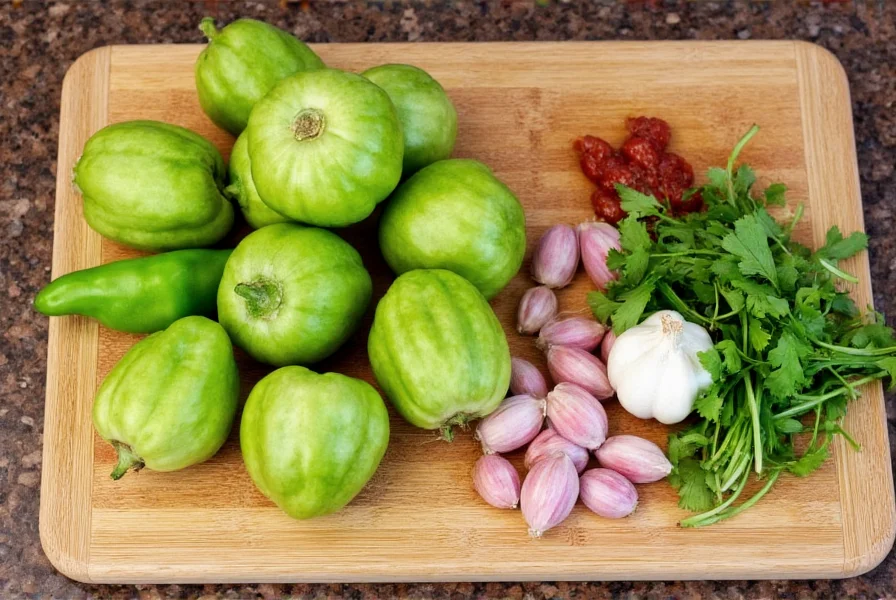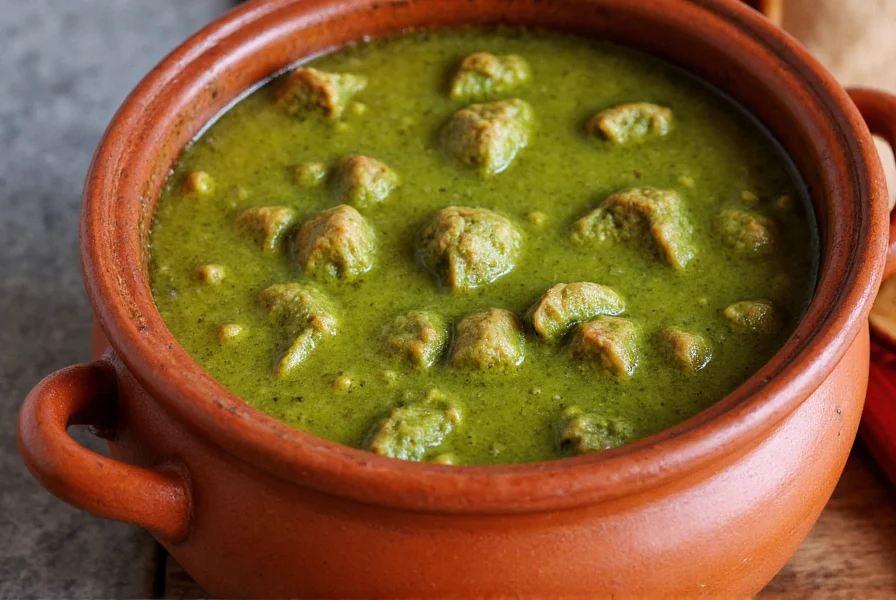Chili verde, meaning "green chili," originates from central and northern Mexico where it's known as chile verde or verde con carne. Unlike its red counterpart, this dish gets its distinctive color and tangy flavor from tomatillos rather than tomatoes. Many modern recipes compromise authenticity by using shortcuts like canned tomatillos or substituting ingredients, but the traditional preparation requires specific techniques and fresh components that create the complex flavor profile characteristic of genuine Mexican cuisine.
What Makes a Chili Verde Recipe Authentic
The difference between authentic and inauthentic chili verde comes down to three critical elements: ingredients, preparation method, and cultural context. Authentic recipes honor the dish's Mexican heritage by using traditional components without Americanized substitutions. The most common inauthentic adaptations include using green tomatoes instead of tomatillos, adding cumin (which isn't traditional in most regional versions), or using pre-made salsa verde from a jar.
True Mexican chili verde features:
- Fresh, roasted tomatillos as the base (not canned or substituted with green tomatoes)
- Traditional Mexican chilies like serrano or jalapeño (not Anaheim or poblano)
- Pork shoulder as the primary meat (not chicken or beef)
- Fresh cilantro and epazote for authentic flavor
- No cumin or other spices not traditionally used in Mexican versions
- Preparation that involves roasting fresh ingredients rather than using canned products
| Authentic Ingredient | Inauthentic Substitute | Why It Matters |
|---|---|---|
| Fresh tomatillos | Canned tomatillos or green tomatoes | Fresh tomatillos provide brighter, more complex flavor and proper texture |
| Serrano or jalapeño peppers | Green bell peppers or Anaheim | Traditional chilies offer authentic heat level and flavor profile |
| Pork shoulder (chuck or butt) | Chicken breast or ground beef | Pork's fat content creates richer sauce and traditional texture |
| Fresh cilantro and epazote | Dried herbs or oregano | Fresh herbs provide distinctive flavor essential to authentic preparation |
Traditional Ingredients for Authentic Chili Verde
The magic of authentic chili verde lies in its relatively simple but carefully selected ingredients. Each component serves a specific purpose in creating the complex flavor profile that distinguishes genuine Mexican preparation from Americanized versions.
Tomatillos - Often called Mexican husk tomatoes, these small green fruits are the foundation of authentic chili verde. When selecting tomatillos, choose firm, bright green specimens with tight husks. The husks should be dry and papery, not moist or moldy. Avoid substituting green tomatoes, which lack the distinctive tartness and texture of tomatillos.
Chilies - Authentic recipes typically use serrano peppers for more heat or jalapeños for milder flavor. The chilies should be fresh, not dried, and roasted to develop their flavor. The seeds and membranes control the heat level - remove them for milder chili verde.
Pork - Traditional chili verde uses pork shoulder (also called pork butt), which contains the right fat-to-meat ratio for slow cooking. The fat renders during cooking, creating a rich, unctuous sauce that would be impossible with leaner cuts.
Herbs and aromatics - Fresh cilantro is essential, while epazote (a traditional Mexican herb) adds distinctive earthiness. White onion, garlic, and Mexican oregano complete the flavor profile without the cumin that often appears in Tex-Mex versions.

Step-by-Step Authentic Preparation Method
The preparation technique is as important as the ingredients when creating authentic chili verde. Traditional Mexican cooking emphasizes roasting fresh ingredients to develop complex flavors before combining them.
- Prepare the tomatillos: Remove husks and rinse tomatillos under cold water to remove sticky residue. Place on a baking sheet and roast at 400°F (200°C) for 15-20 minutes until softened and slightly charred.
- Roast the chilies and aromatics: Place whole serrano or jalapeño peppers, unpeeled garlic cloves, and quartered white onion on the same baking sheet. Roast for 10-15 minutes until blistered and softened. For milder chili, remove seeds from chilies before roasting.
- Prepare the pork: Cut 2 pounds of pork shoulder into 2-inch cubes, trimming excess fat but leaving some for flavor. Season with salt and pepper.
- Brown the pork: In a large Dutch oven or heavy pot, brown the pork in batches over medium-high heat. This step develops flavor through the Maillard reaction and should not be skipped.
- Make the sauce: Transfer roasted tomatillos, chilies, garlic, and onion to a blender. Add 1/4 cup fresh cilantro leaves, 1 tablespoon Mexican oregano, and 1/2 teaspoon epazote (if available). Blend until smooth, adding a small amount of broth only if necessary.
- Simmer the chili: Pour the blended sauce over the browned pork. Add 1 cup chicken or pork broth. Bring to a simmer, then reduce heat to low. Cover and cook for 1.5-2 hours until pork is fork-tender and sauce has thickened.
- Final seasoning: Stir in additional fresh cilantro and adjust salt to taste. Authentic chili verde should have a balanced tangy, savory flavor with moderate heat.

Common Mistakes That Ruin Authenticity
Many home cooks unintentionally compromise the authenticity of their chili verde through common mistakes:
- Using canned tomatillos - While convenient, canned tomatillos have a different texture and flavor profile than fresh roasted ones. The metallic taste from cans detracts from authenticity.
- Substituting green tomatoes - Green tomatoes lack the tartness and pectin structure of tomatillos, resulting in a completely different flavor and texture.
- Adding cumin - While popular in Tex-Mex versions, cumin is not traditional in authentic Mexican chili verde recipes from central or northern regions.
- Overcooking the sauce - Authentic chili verde maintains a vibrant green color. Overcooking causes the sauce to turn olive green and lose its fresh flavor.
- Using lean meat - Pork tenderloin or chicken breast creates a dry, less flavorful result compared to the traditional pork shoulder.
- Skipping the roasting step - Raw tomatillos and chilies create a harsh, one-dimensional flavor compared to the complex notes developed through roasting.
Serving Authentic Chili Verde
In Mexico, chili verde is traditionally served with simple accompaniments that highlight the main dish rather than compete with it. The most authentic presentation includes:
- Warm corn tortillas on the side for making tacos
- White rice (arroz blanco) to balance the flavors
- Freshly chopped white onion and cilantro as garnish
- Lime wedges for squeezing over the top
- Crumbled queso fresco or cotija cheese (optional)
Avoid serving authentic chili verde with Americanized additions like sour cream, shredded cheddar cheese, or pre-made tortilla chips. These additions reflect Tex-Mex interpretations rather than traditional Mexican presentation.
Storage and Reheating for Best Flavor
Authentic chili verde often tastes even better the next day as the flavors continue to meld. Proper storage maintains the integrity of the dish:
- Refrigerate in an airtight container for up to 4 days
- Freeze for up to 3 months in portion-sized containers
- Reheat gently on the stovetop over low heat, adding a splash of broth if needed
- Avoid microwaving, which can cause the sauce to separate and lose its vibrant color
The sauce may thicken when refrigerated - simply add a small amount of broth or water when reheating to restore the proper consistency. The vibrant green color may fade slightly over time, which is normal in authentic preparations without artificial colorings.
Frequently Asked Questions
What's the difference between chili verde and salsa verde?
Chili verde is a complete stew with meat (traditionally pork) simmered in a tomatillo-based sauce, while salsa verde is a condiment made from tomatillos, chilies, and herbs. Salsa verde serves as a topping or dip, whereas chili verde is a main dish with a thicker consistency and longer cooking time that develops deeper flavors.
Can I make authentic chili verde without pork?
Traditional authentic chili verde always includes pork, specifically pork shoulder. While vegetarian versions exist, they wouldn't be considered authentic to the original Mexican preparation. The pork's fat content is essential for developing the rich, complex sauce that characterizes genuine chili verde.
Why is my authentic chili verde turning brown?
Authentic chili verde should maintain a vibrant green color. Browning occurs when the sauce is overcooked or exposed to air for too long. To preserve the green color, avoid boiling the sauce vigorously, don't cook it for more than 2 hours, and store it in an airtight container. The chlorophyll in the fresh ingredients breaks down with excessive heat and oxygen exposure.
What makes a chili verde recipe truly authentic Mexican?
An authentic Mexican chili verde recipe features fresh roasted tomatillos as the base (not canned), traditional Mexican chilies like serrano or jalapeño, pork shoulder as the meat, and fresh cilantro and epazote for flavoring. It avoids Americanized additions like cumin, green tomatoes, or dairy products, and follows traditional preparation methods including roasting fresh ingredients before blending and slow-simmering the stew.
How can I adjust the heat level in authentic chili verde?
To control heat in authentic chili verde, adjust the number of seeds and membranes in the chilies. For milder flavor, remove all seeds and membranes from serrano or jalapeño peppers before roasting. For hotter chili, include more seeds or add extra chilies. Remember that authentic preparation uses fresh chilies rather than processed hot sauces, so the heat develops gradually during cooking and mellow slightly when served.











 浙公网安备
33010002000092号
浙公网安备
33010002000092号 浙B2-20120091-4
浙B2-20120091-4